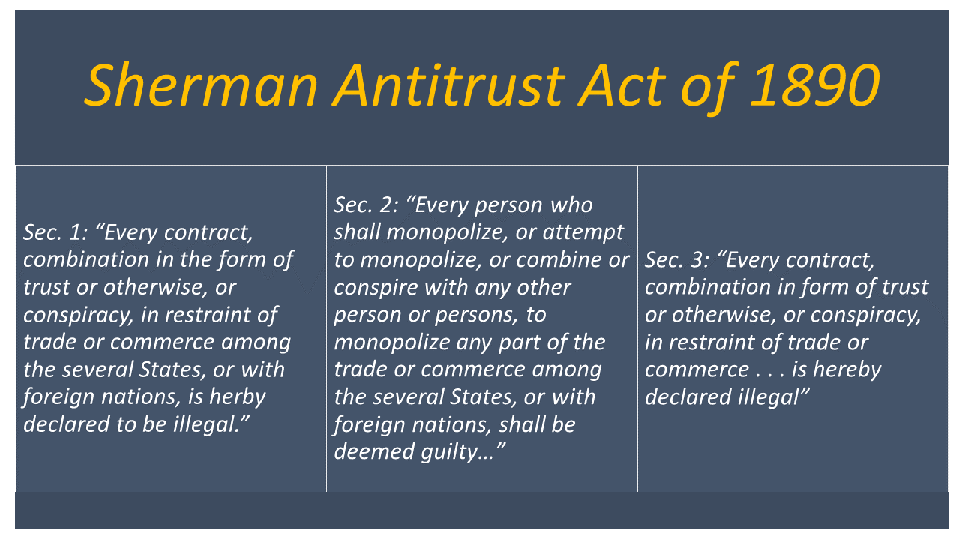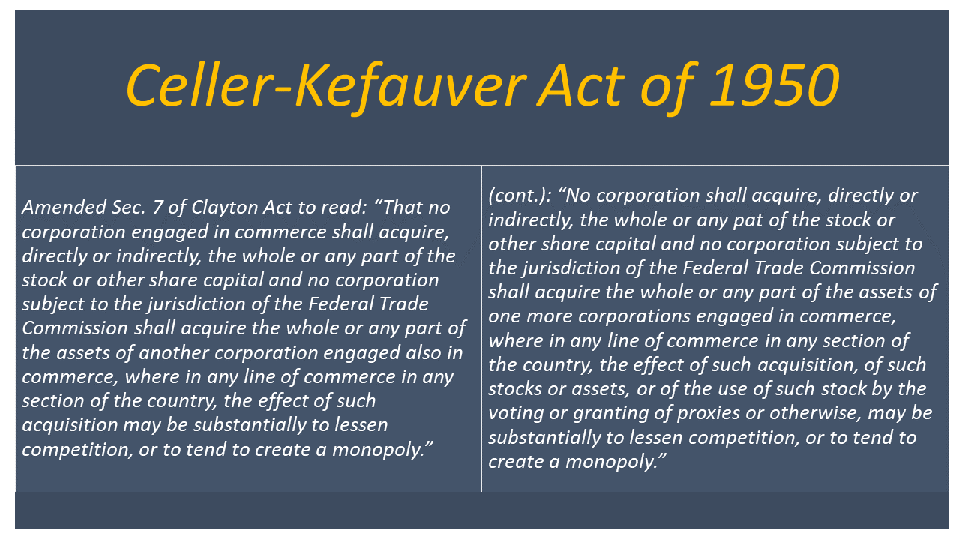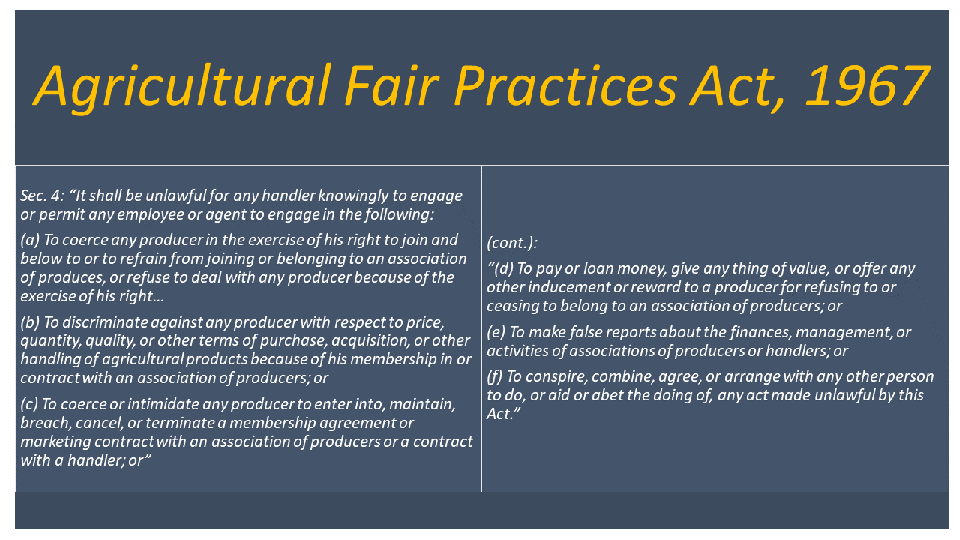On Agriculture & Antitrust: A Brief Summary of Legislative History
Increased prices, new and continuing supply chain problems, and more in the wake of Russia’s unprovoked war on Ukraine and the Covid-19 pandemic may be reinvigorating discussions and questions about the markets, competition, antitrust and agriculture (see e.g., farmdoc daily, April 26, 2022; April 13, 2022; April 5, 2022; and Irwin, April 14, 2022). From fertilizer prices to cattle markets, the issues are increasingly in the spotlight, front and center in policy discussions (see e.g., U.S. Senate, Committee on Agriculture, Nutrition, and Forestry, Hearing, April 26, 2022; House Committee on Agriculture, Hearings, April 27, 2022). Antitrust and competition policies possess a long, complicated history and agriculture has often been in the middle of the discussion. For background to the discussion, this article presents a summary review of the legislative history for the major antitrust, antimonopoly and fair competition statutes.
Background
U.S. antitrust legislation originated in the era known as the Gilded Age at the end of the 19th Century; it was the reign of the Robber Barons, famous names such as Andrew Carnegie, John Pierpont Morgan and John D. Rockefeller. The years around the turn of the 20th Century were dominated by the Trust Movement, in which economic concepts were mixed with Social Darwinism to achieve the goal of monopoly control across all sectors. At the time, the trusts were new entities that sought to eliminate competition and competitors, accumulating vast amounts of wealth and power, including political power. As just one example, to create the U.S. Steel monopoly, J.P. Morgan bought out Andrew Carnegie for an amount that made Carnegie the richest man in the world. Morgan also created the Northern Securities Company to monopolize the western railroads and, of course, Rockefeller created the Standard Oil Company, which monopolized the oil industry and abused power through a cartel with the railroads. For American agriculture these issues were prevalent and important; commodity trusts were also created, including for tobacco, cotton and sugar, while monopolization in the railroad sector was particularly problematic for farmers. (see e.g., Sawyer 2019; Wu 2018; Hovenkamp 2015).
Discussion: Legislative History of Antitrust Law
(1) The Sherman Antitrust Act, 1890
Senator John Sherman (R-OH), the younger brother of the famous Civil War general William T. Sherman, introduced legislation to protect trade and commerce from “unlawful restraints and monopoly” (S.1 of the 51st Congress; December 4, 1889; H. Rept. 51-1707). On the Senate floor, he argued against the “new form of combination commonly called trusts, that seeks to avoid competition” by “placing the power and property of the combination under a few individuals, and often under the control of a single man” and that the “sole object of such a combination is to make competition impossible.” He added that if the “concentrated powers of this combination are intrusted [sic] to a single man, it is a kingly prerogative, inconsistent with our form of government, and should be subject to the strong resistance of the State and national authorities,” because if the United States “will not endure a king as a political power we should not endure a king over the production, transportation, and sale of any of the necessaries of life” (Congressional Record, March 21, 1890, at 2457).
The Sherman Act passed the Senate on April 8, 1890, by a vote of 52 to 1 (29 absent) (Congressional Record, April 8, 1890, at 3152-43). The House amended the Senate bill and passed it without a recorded vote on May 1, 1890 (Congressional Record, May 1, 1890, at 4104). The Senate concurred in the conference report on June 18, 1890, by unanimous consent and without further debate or votes (Congressional Record, June 18, 1890, at 6208). The House agreed to the conference report on June 20, 1890, by a vote of 212 to 0 (85 not voting) (Congressional Record, June 20, 1890, at 6314). President Benjamin Harrison, the 23rd President (1889 to 1893) and graduate of Miami University in Oxford, Ohio, signed the Sherman Act into law on July 2, 1890 (Congressional Record, July 2, 1890, at 6922; The White House, Presidents: Benjamin Harrison). Figure 1 illustrates the voting in Congress on the Sherman Act and Figure 2 summarizes the Act’s key provisions.
Figure 1.Summary of Votes on Sherman Antitrust Act
Figure 2. Summary of Sherman Antitrust Act

(2) The Clayton Antitrust Act, 1914
The Sherman Antitrust Act languished somewhat in the hands of the Courts and the Department of Justice, until the presidency of Theodore Roosevelt, the country’s most famous Trustbuster. Roosevelt’s DOJ first went after Morgan’s Northern Securities Company in 1902 (Morris 2001, at 87-93; Sawyer 2019). It would be two dozen years before Congress took up the issue again.
On April 14, 1914, Representative Henry De Lamar Clayton Jr. (D-AL), chairman of the House Judiciary Committee, introduced legislation to supplement the Sherman Antitrust Act (63rd Congress, 2d Session; H.R. 15657). The House agreed to the bill on June 5, 1914, by a vote of 277 to 54 (3 voted present; 99 not voting) (Congressional Record, June 5, 1914, at 9911). The Senate agreed to the legislation on September 2, 1914, by a vote of 46 to 16 (34 not voting) (Congressional Record, September 2, 1914, at 14610). The Senate agreed to the conference report on October 5, 1914, by a vote of 35 to 24 (37 not voting) (Congressional Record, October 5, 1914, at 16170). The House passed the conference report on October 8, 1914, by a vote of 245 to 52 (5 voted present; 126 not voting) (Congressional Record, October 8, 1914, at 16344). President Woodrow Wilson signed the Clayton Antitrust Act into law on October 15, 1914 (see, Congressional Record, October 16, 1914, at 16756; P.L. 63-212). Figures 3 illustrates the votes on the Clayton Act and Figure 4 summarizes key provisions.
Figure 3. Votes on Clayton Antitrust Act
Figure 4. Summary of Clayton Antitrust Act

(3) The Packers and Stockyards Act, 1921
Introduced by Representative Gilbert N. Haugen (R-IA), chairman of the House Agriculture Committee, on May 8, 1921, to “regulate interstate and foreign commerce in live[]stock, live-stock products, dairy products, poultry, poultry products and eggs” and providing the Secretary of Agriculture with “jurisdiction over the packers, stockyards, commission men, traders, buyers, and sellers in the stockyard” (67th Congress, 1st Session; H.R. 6320; H. Rept. 67-77). The House agreed to the bill without a recorded vote on May 31, 1921 (Congressional Record, May 31, 1921, at 1932). The Senate agreed to its version of the bill on June 17, 1921, by a vote of 45 to 21 (30 not voting) (Congressional Record, June 17, 1921, at 2713). The conference committee reported a final version of the legislation on August 2, 1921 (H. Rept. 67-324). The Senate agreed to the conference report on August 4, 1921, by a vote of 48 to 10 (38 not voting) (Congressional Record, August 4, 1921, at 4644). The House agreed to the conference report on August 9, 1921, again without a recorded vote (Congressional Record, August 9, 1921, at 4787). President Warren G. Harding signed it into law on August 15, 1921 (P.L. 67-51). Figure 5 illustrates the votes in Congress on the Packers & Stockyards Act and Figure 6 provides a summary of key provisions.
Figure 5. Votes on P&SA 1921
Figure 6. Summary of P&SA 1921

(4) The Robinson-Patman Act, 1936: Price Discrimination
Introduced on June 11, 1935, by Representative Wright Patman (D-TX), to make it “unlawful for any person engaged in commerce to discriminate in price or terms of sale” it was not reported out by the House Judiciary Committee until March 31, 1936 (74th Congress, 2d Session, June 11, 1935, H.R. 8442; H. Rept. 74-2287). Senator Joseph T. Robinson (D-AR) and Senate Majority Leader introduced the Senate version of the price discrimination bill on May 13, 1936, which was reported by the Senate Judiciary Committee on February 3, 1936 (74th Congress, 1st Session, S.3154; S. Rept. 74-1502). The Senate agreed to its version on April 30, 1936, by unanimous consent (Congressional Record, April 30, 1936, at 6436). The House agreed to its version of the bill on a division vote of 290 to 16 on May 28, 1936 (Congressional Record, May 28, 1936, at 8242). The House agreed to the conference report on June 15, 1936, without a recorded vote (Congressional Record, June 15, 1936, at 9422). The Senate agreed to the conference report by unanimous consent on June 18, 1936 (Congressional Record, June 18, 1936, at 9904). President Franklin Roosevelt signed it into law on June 10, 1936, amending Section 2 of the antitrust statute as it had been supplemented by the 1914 Clayton Antitrust Act (P.L. 74-692). Figure 7 illustrates the voting in Congress and Figure 8 summarizes the provisions of the law.
Figure 7. Votes on Price Discrimination Bill, 1936
Figure 8. Summary of Price Discrimination Bill, 1936

(5) The Celler-Kefauver Act, 1950: Mergers and Acquisitions
Representative Emmanuel Celler (D-NY) introduced legislation to amend the Clayton Antitrust Act on February 15, 1949, which was reported by the House Judiciary Committee August 4, 1949 (81st Congress, 1st Session, February 15, 1949, H.R. 2734; H. Rept. 81-1191). The House passed it on suspension of the rules on August 15, 1949, by a vote of 223 to 92 (117 not voting) (Congressional Record, August 15, 1949, at 11507). The Senate Judiciary Committee reported its amendments to the bill on June 2, 1950 (S. Rept. 81-1775). The Senate did not agree to the bill until December 13, 1950, which Senators passed by a vote of 55 to 22 (19 not voting) (Congressional Record, December 13, 1950, at 16508). The House concurred in the Senate amendments without further consideration or a recorded vote on December 14, 1950 (Congressional Record, December 14, 1950, at 16574). President Harry Truman signed the bill into law on December 29, 1950 (P.L. 81-899). Figure 9 illustrates the votes in Congress and Figure 10 summarizes the amendments to the antitrust laws.
Figure 9. Votes on Celler-Kefauver, 1950
Figure 10. Summary of Celler-Kefauver, 1950

(6) Agricultural Fair Practices Act of 1967
On January 11, 1967, Senator George Aiken (R-VT) introduced legislation to “control unfair trade practices affecting producers of agricultural products and associations of such producers” and, although he was the ranking member of the Agriculture and Forestry Committee, he was listed as the lead in reporting it to the Senate on August 3, 1967 (90th Congress, 1st Session, January 11, 1967, S.109; S. Rept. 90-474). He had introduced the bill in the previous Congress as well. The Senate passed it by unanimous consent on August 4, 1967 (Congressional Record, August 4, 1967, at 21411). The House agreed to an amended version on March 25, 1968, by a vote of 232 to 90 (111 not voting) (Congressional Record, March 25, 1968, at 7468). Senator Aiken, noting that the House had made no major changes to the bill, requested the Senate concur in the House amendment. The Senate concurred in the House amendment by unanimous consent on April 1, 1968 (Congressional Record, Aril 1, 1968, at 8419). President Lyndon B. Johnson signed the bill into law on April 16, 1968 (P.L. 90-288). Figure 11 illustrates the voting in Congress and Figure 12 summarizes the Act.
Figure 11. Votes on Ag Fair Practices Act, 1967
Figure 12. Summary of Ag Fair Practices Act, 1967
Concluding Thoughts
Today, the antitrust statutes occupy Chapter 1 of the title on Commerce and Trade, with the Sherman Act in the first seven sections (15 U.S.C. §§1-38). Federal law on the matter still opens with the broad declaration that “[e]very contract, combination in the form of trust or otherwise, or conspiracy, in restraint of trade or commerce . . . is declared illegal” (15 U.S.C. §1). The statute and its legislative history present only part of the history for competition and antitrust law in the United States. The Federal Judiciary has played an enormous and profound role, but any exploration of the topic should begin with the provisions of the U.S. Code and a basic understanding of how the law came to be, and what Congress intended. There is a through line, a single connecting thread that runs through the legislation from 1890 onward, and it is the fundamental importance of competition, the protection of fair, equitable, functional and robust competition. The protection of competition by the rule of law rather than the rule of the wealthiest or most powerful is the North Star of antitrust law.
References
Hovenkamp, Herbert. The Opening of American Law: Neoclassical Legal Thought, 1870-1970 (New York: Oxford University Press 2015).
Morris, Edmund. Theodore Rex (New York: The Modern Library 2001).
Sawyer, Laura Phillips. “US Antitrust Law and Policy in Historical Perspective.” In Oxford Research Encyclopedia of American History. 2019, available online: https://www.hbs.edu/ris/Publication%20Files/19-110_e21447ad-d98a-451f-8ef0-ba42209018e6.pdf.
U.S. House of Representatives, Committee on the Judiciary, “Protection of Trade and Commerce Against Unlawful Restraints and Monopolies,” Report to accompany S. 1, H. Rept. 51-1707 (51st Congress, 1st Session; April 25, 1890).
U.S. House of Representatives, Committee on Agriculture, “Interstate and Foreign Commerce in Live Stock, Live-Stock Products, Etc.,” Report to accompany H.R. 6320, H. Rept. 67-77 (67th Congress, 1st Session; May 18, 1921).
U.S. House of Representatives, “Meat-Packing Industry,” Conference Report to accompany H.R. 6320, H. Rept. 67-324 (67th Congress, 1st Session; August 2, 1921).
U.S. House of Representatives, Committee on the Judiciary, “Prohibition on Price Discrimination,” Report to accompany H.R. 8442, H. Rept. 74-2287 (74th Congress, 2d Session; March 31, 1936).
U.S. House of Representatives, Committee on the Judiciary, “Amending an Act Entitled “An Act to Supplement Existing Laws Against Unlawful Restraints and Monopolies…,” Report to accompany H.R. 2734, H. Rept. 81-1191 (81st Congress, 1st Session; August 4, 1949).
U.S. Senate, Committee on the Judiciary, “To Amend Antitrust Act,” Report to accompany S.3154, S. Rept. 74-1502 (74th Congress, 2d Session; January 16, 1936)
U.S. Senate, Committee on the Judiciary, “Amending an Act Entitled “An Act to Supplement Existing laws Against Unlawful Restraints and Monopolies…,” Report to accompany H.R. 2734, S. Rept. 81-1775 (81st Congress, 2d Session; June 2, 1950).
U.S. Senate, Committee on Agriculture and Forestry, “Agricultural Fair Practices,” Report to accompany S. 109, S. Rept. 90-474 (90th Congress, 1st Session; August 3, 1967).
Wu, Tim. The Curse of Bigness: Antitrust in the New Gilded Age (New York: Columbia Global Reports 2018).
Disclaimer: We request all readers, electronic media and others follow our citation guidelines when re-posting articles from farmdoc daily. Guidelines are available here. The farmdoc daily website falls under University of Illinois copyright and intellectual property rights. For a detailed statement, please see the University of Illinois Copyright Information and Policies here.






























